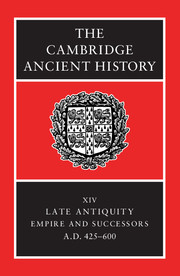Book contents
- Frontmatter
- PART I CHRONOLOGICAL OVERVIEW
- PART II GOVERNMENT AND INSTITUTIONS
- PART III EAST AND WEST: ECONOMY AND SOCIETY
- 12 Land, labour and settlement
- 13 Specialized production and exchange
- 14 The family in the late Roman world
- 15 Family and friendship in the west
- 16 State, lordship and community in the west (c. A.D. 400–600)
- 17 Armies and society in the later Roman world
- PART IV THE PROVINCES AND THE NON-ROMAN WORLD
- PART V RELIGION AND CULTURE
- Conclusion
- Chronological Table
- BIBLIOGRAPHY
- Index
- References
12 - Land, labour and settlement
from PART III - EAST AND WEST: ECONOMY AND SOCIETY
Published online by Cambridge University Press: 28 March 2008
- Frontmatter
- PART I CHRONOLOGICAL OVERVIEW
- PART II GOVERNMENT AND INSTITUTIONS
- PART III EAST AND WEST: ECONOMY AND SOCIETY
- 12 Land, labour and settlement
- 13 Specialized production and exchange
- 14 The family in the late Roman world
- 15 Family and friendship in the west
- 16 State, lordship and community in the west (c. A.D. 400–600)
- 17 Armies and society in the later Roman world
- PART IV THE PROVINCES AND THE NON-ROMAN WORLD
- PART V RELIGION AND CULTURE
- Conclusion
- Chronological Table
- BIBLIOGRAPHY
- Index
- References
Summary
THE ISSUES AND THE EVIDENCE
The vast majority of the population of the Roman empire, as in all pre-modern societies, worked on the land. There is a great deal we would like to know about these people: exactly how many they were; how many others they fed (whether artisans, soldiers and clergy, or idle rich); which areas they cultivated, and with what crops and which methods; to what extent their agriculture was specialized and tied into commercial networks of exchange; what types of settlement they lived in; and how tightly their labour was controlled – how many agricultural workers were free peasants cultivating their own plots, and how many dependent tenants of great landlords, wage labourers, or even slaves?
In looking at these questions for the fifth and sixth century we are often moving from a period in which the data are severely restricted into one in which they are almost completely absent. However, by combining written and archaeological evidence, and with the aid of some informed guesswork, we can sometimes at least refine the questions, even if we cannot honestly provide any very firm answers to them.
Over the last thirty to forty years, our picture of the Roman and late Roman countryside has been greatly enhanced, and in some areas transformed, by archaeology. When, in 1964, Jones published his magisterial account of the late Roman empire, he was still able largely to ignore archaeological evidence when discussing rural life.
- Type
- Chapter
- Information
- The Cambridge Ancient History , pp. 315 - 345Publisher: Cambridge University PressPrint publication year: 2001
References
- 7
- Cited by

